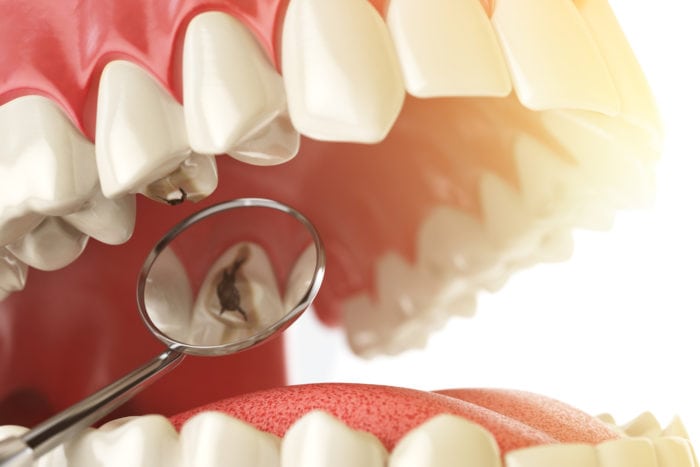Tooth decay is one of the most pervasive diseases of our time but modern dentistry has made major strides in the battle against cavities. Based on years of scientific and clinical research, dentists are now moving towards an approach to dental caries (tooth decay) management that is tailored to your personal risk rather than a “one size fits all.” The previous method of “drilling and filling” to treat decay does not actually change the conditions that lead to the disease and the risk for further infection still remains. By profiling the degree of risk and implementing individualized preventive strategies, today’s dental professionals are using a more proactive approach — that works.
Dental Decay — A Dynamic Infectious Disease Process
The mouth is an ecosystem — living organisms continually interact with every other element in their environment. The teeth are composed of an outer covering of enamel, a highly mineralized crystalline structure composed mainly of calcium and phosphate. They are also bathed in a remarkable fluid — saliva, which plays a crucial role in maintaining a neutral environment or balance between the acids and bases in your mouth.
Acidity is measured by the pH scale, which ranges from 1 – 14. A pH value of 1 is extremely acidic while a pH value of 14 is extremely basic. The pH of the mouth is generally 7 — neutral. Specific acid producing (acidogenic) bacteria attach themselves to dental plaque, the whitish sticky biofilm that collects and forms on the teeth. When you eat sugars or carbohydrates, these particular bacteria break down the sugars and produce acid as a by-product, which also makes the mouth more acid. At about pH 5.5, the minerals just below the enamel surface of the teeth begin to dissolve or “de-mineralize.” During this process, more calcium and phosphate leave the surface of the teeth than enter it — the first step in the decay process. And because the layer beneath the enamel, and the roots of teeth are made of dentin, which is softer than enamel, it is more susceptible to decay. For example, the roots of an exposed tooth will de-mineralize quickly and easily with even weak acids at pH 6.2 – 6.8, which is closer to neutral saliva.
Why Me? Individualizing Risk Assessment
Given similar habits, you might wonder why some people get cavities and others don’t? Dr. John Featherstone, an imminent researcher, introduced the concept of the Caries Balance in 2002, in which he demonstrated that dental caries (tooth decay) and dental health are the result of a delicate balance between pathologic (disease causing) and protective (health promoting) factors. Each person has his/her own unique balance that is constantly changing. The challenge is to identify what is out of balance and how to tip it towards health and protection.
Caries risk assessment can be likened to that for cardiovascular (“cardio” – heart; “vascular” – blood vessel) disease wherein a physician reviews your health history, takes your blood pressure, monitors your heart, and provides an individualized treatment plan to reduce or manage risk. If your blood pressure is high, it doesn’t indicate that you have had a heart attack or stroke or that you definitely will one day. However, it does mean that you are at a higher risk and it would be wise to take preventive actions.
Disease Indicators
Disease Indicators work by showing you what could happen based on what has happened. Identifying them includes the use of modern dentistry’s most sophisticated tools for early diagnosis of decay.
They include:
-Visible cavities (decay) that is visible in teeth ranging from very early (microscopic) detection using, for example, laser technology, to cavities that are visible to the naked eye.
-X-ray pictures show early decay that is visible by using today’s highly sensitive yet low dosage x-rays.
-White spot lesions are the first sign of decay in the contacting areas of adjacent teeth that are often reversible with fluorides.
-Cavities within the last 3 years — any previous cavities add to your risk.
Risk Factors
Risk Factors are those associated with an increased chance of disease or infection. They may be linked to a disease, but do not necessarily cause it.
They include:
-Visible plaque that you can see, means there’s a lot of it. And if your mouth is acidic, your plaque (biofilm) is especially prone to contain decay producing (acidogenic) bacteria.
-Inadequate saliva flow leads to dry mouth or if the ability of your saliva to neutralize acid is diminished, protection against decay is seriously compromised.
-Many medications can cause mouth dryness and in addition, diseases that result in lack of saliva result in diminished ability to neutralize acid. Both significantly increase the risk of decay.
-Frequent snacking, eating sugars, refined carbohydrates, and acidic foods actually promote acid producing “BAD” bacteria.
-Appliances: Retainers, orthodontic appliances, and bite or night guards all tend to restrict saliva flow over the teeth causing stagnation and promotion of bacterial plaque (biofilm).
-Deep “pits and fissures,” the shapes of teeth vary from person to person; your genetic make-up controls how deep the tiny grooves (fissures) and pits are on your tooth surfaces. The deeper they are, the more likely they are to harbor bacteria.
-Acidic beverages or foods not only increase the growth of acid loving (aciduric) bacteria, but they can also cause erosion of enamel.
-Other conditions, like bulimia and anorexia (psychological states in which individuals induce vomiting), and Gastro-Esophageal Reflux Disease (GERD) can create highly acidic conditions in the mouth causing severe erosive damage to teeth.
Finally, it’s about partnership. Your relationship with your dental office team is based on both a scientific approach as well as caring health professionals who working together will ensure dental decay is a disease of your past.




0 comments on “Tooth Decay — How To Assess Your Risk”